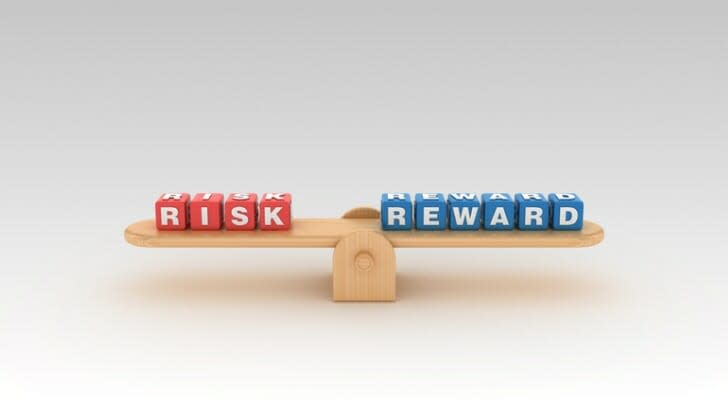Everyone loves seeing growth in their portfolio. However, a good year of investing doesn’t necessarily indicate a sound long-term investment strategy. Generating sufficient retirement income means planning ahead of time but being able to adapt to evolving circ*mstances. As a result, keeping a realistic rate of return in mind can help you aim for a defined target. Many consider a conservative rate of return in retirement 10% or less because of historical returns. Here’s what you need to know.
Need help planning for retirement? A financial advisor can help you manage your portfolio, figure out how much income you’ll need and assist in other important decisions.
What Is a Realistic Rate of Return for Retirement?
Understanding a realistic rate of return will help you create an accurate retirement plan. However, doing so requires diving deeper than the nominal rate of return, which is the income generated by your investments before accounting for administration fees, taxes, and inflation.
Focusing on the nominal rate of return can give you a false idea of how much income you’ll receive from your investments. Instead, the real rate of return will help you understand how much money you’ll have in your pocket in retirement.
For example, say you invest in a fund that historically provides an 8% nominal rate of return. However, the fund has a 0.5% management fee, and inflation is 3%. Therefore, you subtract 3.5% of the return before it hits your wallet. This means your holdings are actually generating a 4.5% return. So, if you invest $100,000, you’d see a real return of $4,500 due to fees and inflation.
Then, if your retirement account isn’t a Roth account, you’ll also pay income taxes. Depending on your tax bracket, you’ll would pay between 10% and 37%. As a result, the 8% rate of return is a surface-level indicator of the investment’s performance. In an environment with high inflation and taxes, your real return could be next to nothing.
That said, investments can still be an excellent source of retirement income. For example, the stock market has provided about a 10% return over the last 50 years, as seen specifically with the S&P 500. Adjusted for an average inflation rate of 3%, that’s a 7% return before administration fees (which you can keep low by finding an inexpensive investment firm) and taxes (which vary from person to person).
Factors That Determine Your Rate of Return in Retirement
Your rate of return is also subject to factors beyond taxes, fees, and inflation. They vary due to individual circ*mstances and preferences. These are the key factors to pay mind to:
Risk Tolerance
High returns come with high risk when investing. As a result, younger investors tend to have more risk tolerance because they can make up for early losses. However, your risk tolerance usually drops as you age and enter retirement. After all, seeing your $1.5 million portfolio drop 20% a week before retirement can raise concerns about whether your nest egg will be sufficient.
Therefore, it’s crucial to note the stage of life you’re in and how much risk you can handle. For example, a conservative investor may want to allocate more of their portfolio to bonds, even if they have decades before retirement.
Investment Types
Likewise, your investment types will affect your returns. For instance, you might choose two or three of the following assets to create your nest egg:
Stocks
Bonds
Each of these investments comes with its particular rate of return, fees, and unique features. For example, life insurance provides a payout to your beneficiaries upon your death, while certificates of deposit last up to five years before you need to renew them. Therefore, your choice of asset type will influence your income streams and the income level you’ll expect in retirement.
A financial advisor can help you determine an appropriate portfolio allocation based on your goals and circ*mstances. Get matched with a financial advisor today.
Retirement Timeline
When you retire also impacts your portfolio’s rate of return. For instance, those who retired in 2022 likely did so when their portfolios were suffering (the S&P 500 fell by approximately 19%). However, those with plans to retire in 2023 and onwards will have a chance for their investments to recover before relying on them for investment income. Therefore, when you retire can determine your investment’s success as much as your asset selection.
Fluctuating Returns
On that note, realizing that even historically reliable indexes like the S&P 500 have fluctuating returns is essential. In other words, a stock blend with a 15% return last year might take a -10% dive this year. While this dynamic complicates retirement planning, it’s best to look at an asset’s return over time to understand how it may benefit your portfolio. This way, you’ll get an idea of how it performs over the long haul. Just keep in mind that past performance doesn’t guarantee future results.
Annualized vs. Compounding Returns
Whether your returns compound or not puts another wrinkle in retirement planning. Specifically, compounding returns means reinvesting your earnings. A savings account works the same way. Your bank provides an interest payment each month, which combines with your principal and earns more interest in the future.
That said, your retirement account will provide compounding returns until you retire and begin withdrawing money. In other words, if your nest egg grew at a rate of 7% over your career and reached $1 million, it did so by compounding your returns.
However, you’ll use that $70,000 to live on during retirement instead of adding that money on top of the pile to be reinvested. As a result, differentiate between annualized and compounding returns when you need income. Otherwise, you’ll get a false sense of how healthy your portfolio will be 10 years into retirement.
A financial advisor can help you make projections for your own retirement that includes taxes, inflation and more.
Historic Rates of Return for Different Asset Classes
As mentioned previously, returns vary over time. Therefore, it’s helpful to review how they have performed through the past decades.
For example, stocks are profitable but volatile. The S&P 500 returned 37.2% in 1995 and 37.39% in 2013, but it dipped to -37 in 2008 and -19.64% in 2022.
In addition, J.P. Morgan reports annualized returns for numerous asset classes. For example, it reported the 10-year annualized returns for the following from 2012 to 2021:
REITs: 12.2%
Single-family homes: 7.8%
Bonds: 2.9%
Small Cap stocks: 13.2%
60/40 stock/bond blend: 11.1%
J.P. Morgan also reported 20-year annualized returns for the following from 1999 to 2018:
Gold: 7.75%
Oil: 7%
Furthermore, Fidelity Investments provides a report of annualized returns for portfolios of the conservative, balanced, growth, and aggressive growth varieties if you invested from 1926 through 2022. Here are the numbers:
Conservative: 50% bonds, 30% short-term investments, 14% U.S. Stock, and 6% foreign stock.
Average annual return: 5.75%
Worst 12-month return: -17.67%
Best 12-month return: 31.06%
Worst 20-year return: 2.92%
Best 20-year return: 10.98%
Balanced: 40% bonds, 35% U.S. stock, 15% foreign stock, 10% short-term investments.
Average annual return: 7.74%
Worst 12-month return: -40.64%
Best 12-month return: 76.57%
Worst 20-year return: 3.43%
Best 20-year return: 13.84%
Growth: 49% U.S. Stock, 25% bonds, 21% foreign stock, 5% short-term investments.
Average annual return: 8.75%
Worst 12-month return: -52.92%
Best 12-month return: 109.55%
Worst 20-year return: 3.1%
Best 20-year return: 15.34%
Aggressive Growth: 60% U.S. stock, 25% foreign stock, 15% bonds.
Average annual return: 9.45%.
Worst 12-month return: -60.78%
Best 12-month return: 136.07%
Worst 20-year return: 2.66%
Best 20-year return: 16.49%
How to Determine Rates of Return for Retirement Projections?
All these numbers may leave you with the question of how to project future rates of return for your retirement account. Fortunately, several techniques can help you get accurate figures.
Understand Your Asset Class
The assets you invest in will determine your rate of return. For instance, if you want high returns and can tolerate risk, steer clear of bonds. Sure, they’ll sit and provide a modest return, but they won’t fit your preferences (stocks would be a better fit). So, it’s a good idea to have basic knowledge of the various asset classes before sinking money into an investment.
Adjust to the Circ*mstances
A 25-year-old will likely invest in a growth fund with plenty of stocks. This move makes sense because they can take advantage of higher gains while having plenty of time to overcome losses.
However, when that same person is 10 years away from retirement, it may be time to shift a portion of their portfolio away from stocks and into low-risk, low-reward assets, like bonds. In other words, at each stage of life, it’s wise to ask yourself what your goals are and how your investments are helping you get there. Then, you can make suitable changes.
Plan for Multiple Scenarios
There is no guarantee of future investment gains, so it’s best to run your nest egg through multiple calculations to see where you’d land in different circ*mstances. Anticipating various scenarios can allow you to plan for different outcomes, reducing stress and increasing your quality of life.
For example, how much retirement income would you receive if your assets performed exactly as predicted? On the other hand, if your assets only performed as well as their lowest return in the last decade, how much would that change your income? The answers to these questions will help you respond effectively if your investment fund underperforms.
A financial advisor can help you build a comprehensive financial plan includingcontingencies.
How to Maximize Your Rate of Return in Retirement
Maximizing your real rate of return is crucial to maintaining a robust income. Use these tips to keep your cash flow healthy in a volatile market.
Fight Inflation
While inflation impacts working and retired Americans alike, you can combat its effects to make your dollar stretch further. First, you can relocate when you retire to a more affordable place to live. For example, Georgia and Mississippi have a low cost of living and burgeoning retirement communities. Meanwhile, states like Florida and Nevada do not levy state income taxes.
Additionally, your asset class can protect against inflation. For instance, stocks can be effective inflation hedges because corporate profits usually rise during bouts of inflation. Specifically, value stocks (as opposed to dividend stocks or growth stocks) are excellent for insulating you against inflation. So, seeking undervalued stocks is an effective strategy in a high-inflation environment.
Buy Inflation-Linked Bonds
Moreover, a specific bond type can take advantage of inflation. Treasury Inflation-Protected Securities (TIPS) increase their par value when inflation increases. For example, a $1,000 TIPS with a 0.5% interest rate provides a $5 return before inflation. However, if inflation rises 5% for the year, your asset gains $50 more in value. Therefore, TIPS are low-risk assets with a niche role in inflationary settings.
Prioritize Short-Term Bonds
Likewise, bonds also help with inflation because they offer varying timelines before you sell them. Bond interest rates rise with inflation, and short-term bonds respond quickly to market dynamics. So, you can purchase these assets and sell them after a maturity period of one to five years.
Diversify Your Portfolio
Diversification is a key strategy for all investors to follow. Whether you’re dealing with a bull market, extreme inflation or impending retirement, spreading your investments among numerous asset clases will decrease your risk and provide exposure to different industries. However, this doesn’t mean reallocating assets during times of economic turbulence, where emotions run high and judgment isn’t clear. Instead, it’s best to be proactive and diversify your portfolio from the outset.
Keep Moderate Cash Reserves
Although stuffing all your hard-earned money under your mattress is a simpler approach, it won’t sustain you during retirement. Inflation constantly devalues currency, meaning the $100 in your wallet will probably be worth about $98 or $97 the next year during periods of normal inflation. But a market downturn can expose new retirees to sequence of returns risk. As a result, it’s recommended that retirees keep a maximum of two years worth of expenses in cash and invest everything else to generate retirement income.
Bottom Line
A realistic rate of return for retirement depends on your asset allocation, investment management fees, inflation, and taxes. As a result, calculating your real rate of return means accounting for these factors when assessing your investment gains. While inflation impedes returns, you can adopt several strategies, like investing in stocks and inflation-linked bonds, to overcome this obstacle. Remember, diversifying your portfolio and keeping a cool head in difficult times often leads to better outcomes.
Portfolio Management Tips
Managing investments yourself can be a lot to juggle when you’re sifting between stocks and bonds, and aren’t sure how much income you’ll need. Finding a financial advisor doesn’t have to be hard. SmartAsset’s free tool matches you with up to three vetted financial advisors who serve your area, and you can interview your advisor matches at no cost to decide which one is right for you. If you’re ready to find an advisor who can help you achieve your financial goals, get started now.You can also check out SmartAsset reviews.
Diversifying your investments means more than blending stocks and bonds in your portfolio. Here is a guide to 10 investment types and how they work.
Keep an emergency fund on hand in case you run into unexpected expenses. An emergency fund should be liquid -- in an account that isn't at risk of significant fluctuation like the stock market. The tradeoff is that the value of liquid cash can be eroded by inflation. But a high-interest account allows you to earn compound interest.Compare savings accounts from these banks.
Photo credit: ©iStock.com/Andrii Yalanskyi, ©iStock.com/porcorex, ©iStock.com/FangXiaNuo
The post What Is a Realistic Rate of Return for Retirement? appeared first on SmartAsset Blog.



